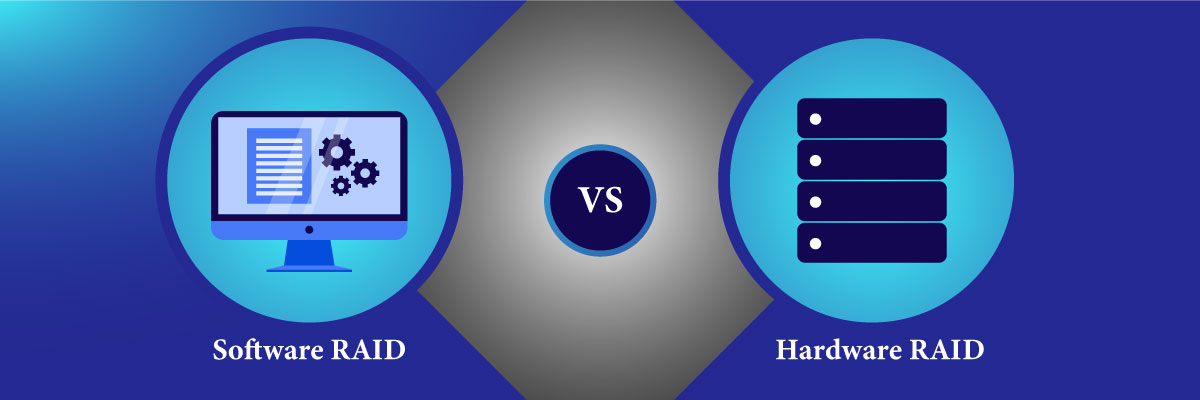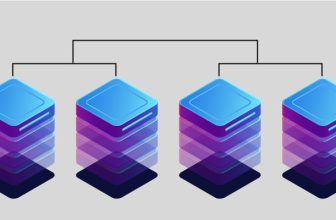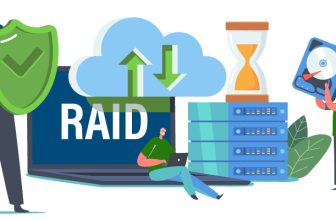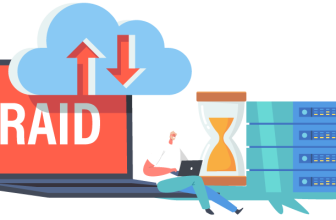Step by Step RAID Comparison: Software RAID vs Hardware RAID

What Exactly is RAID and Why is it so Important?
A Redundant Array of Independent Disks, or RAID, is a technique for logically combining several hard drives into a single set in order to increase storage performance and enhance its management. Now, depending on how your RAID is configured, you’ll be able to reach a specific level of speed and dependability.
RAID is quite helpful if uptime and scalability are essential to your business. A major data loss can be prevented with the aid of backups. Without any downtime or data loss, RAID allows you to survive the failure of one or more discs. RAID is also helpful if your disc I/O problems cause your applications to wait for the discs to complete their responsibilities. By allowing you to read and write data from numerous drives instead of just one, RAID will provide you with more throughput.
What are the Various Raid Configurations?
There are numerous popular RAID configurations. Here is a quick summary of each.
RAID 0 :
RAID 0 is regarded as the most fundamental RAID level. The read/write performance and storage capacity are improved over a single drive by employing two or more drives simultaneously. However, it offers no protection in the event of a drive failure and will raise the risk of a data disaster. All of the data in the RAID 0 array is lost if one drive fails. Mission-critical systems shouldn’t use it.
RAID 1
RAID 1 uses two drives to produce a mirror, which means that everything on each of them is identical. If a drive dies, the controller uses the mirror drive for data recovery and ongoing operation. It provides up to twice the reading performance of a single drive but does not speed up writing. Because all data is written twice, the biggest drawback is that the effective storage capacity is only half of the overall drive capacity.
RAID 2
With RAID 2, every bit of data is striped and written to a different drive or stripe. The logarithm of the number of discs that are protecting the mentioned data is equal to the number of discs in RAID 2 that are employed to store data. Every disc in RAID 2 functions as a single disc with a capacity equal to the total capacity of all data storage discs. Synchronizing all drives is essential while RAID 2 is in use.
RAID 3
Similar to RAID 0, RAID 3 includes a second disc in the array but expressly uses byte-level striping. We can refer to it as “the parity disc” because it is used to store hash algorithms and supports a specific processor in parity code calculation. The configuration information is broken down into discrete bytes and then saved to disk. It enables data recovery in the event of failure by correctly computing the remaining bytes and parity bytes that correspond with them.
RAID 4
RAID 3 and RAID 4 are fairly similar. The primary distinction is how data is shared. They are put on discs after being separated into blocks. Any recorded block is written to a parity disc for every row of written data. In essence, RAID 4 stripes data at the byte level rather than the block level. There are additional similarities to RAID 3, although all parity data is restricted to a single disc. Distributed parity is not utilized in RAID 4.
RAID 5
The most popular and secure RAID level is RAID 5. It gives the advantages of both RAID 0 and RAID 1, offering a fair balance between security, speed, and performance. However, it requires at least three discs and boosts read speeds while degrading write performance. RAID 5 adds parity to the array, which requires a total of one disk’s worth of space. One disc failure is also acceptable at this level.
RAID 6
The principle of RAID 5 is used in RAID 6, but the parity data is written to two drives instead. This calls for a minimum of four discs, and the likelihood of two drives failing simultaneously is, of course, extremely remote. However, if a disc in a RAID 5 fails, rebuilding takes many hours. You will still lose all of your data if a drive fails again. The RAID array will even survive the second failure when using RAID 6.
What is the Main Difference Between Software and Hardware RAID?
One of the most popular techniques for enhancing the effectiveness and capacity of storage media is RAID. Both software and the necessary hardware can be used for RAID. Let’s examine the main distinctions between hardware and software RAID.
Hardware RAID is a processing system whereby the memory drive of a device’s memory is divided using a specialized control unit called a RAID controller. As opposed to that, a more recent RAID strategy is known as software RAID; it is based on the same fundamental principles as hardware RAID but uses software to carry out the procedure.
What are the Benefits and Drawbacks of Using Software RAID?
Utilizing the computing resources of the operating system in which the RAID discs are placed is the main advantage of employing software RAID. Since no additional hardware RAID controller is needed, the cost is reduced. Additionally, it enables users to modify array configurations without being disturbed by a hardware RAID controller.
A key drawback of software RAID is that it is typically slower. It may slow down other server processes as well as the read and write performance of your RAID configuration. It’s a little more difficult to replace damaged discs with software RAID. You must first instruct your system to cease utilizing the disc before you can replace it.
What are the Benefits and Drawbacks of Using Hardware RAID?
Hardware RAID uses controllers to maintain the RAID configuration independently of the operating system. It is a dedicated processing system. The discs that the RAID controller controls do not lose processing power. As a result, data may be read and written with more space and speed. It’s easy to replace a damaged disc; just remove the old one and insert the new one.
Hardware RAID’s main drawback is that it demands additional controller hardware. In comparison to the software RAID, the cost is higher. In order for the RAID system to function as you’ve configured it, you must find a compatible RAID controller to replace the failed one with.
Which is the Best Option? Is it a Software RAID or a Hardware RAID?
Depending on your needs and budget, you should decide between software RAID and hardware RAID. Overall, hardware RAID is more expensive than software RAID but provides higher performance, frees you from software RAID’s restrictions, and gives you more freedom in how you utilize it and the configurations it can handle. Hardware RAID is unquestionably the way to go if your budget permits.






